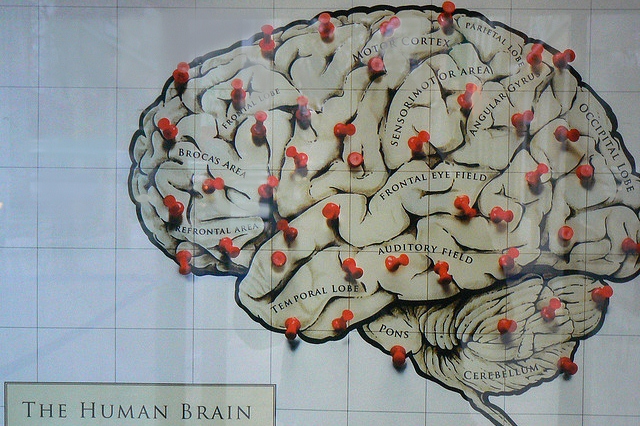FAQ: Brain-Communicators
28 Oct 2016
7 facts about a new model of communication between humans and the environment
In 1999, US researchers published an interesting article. Imagine: a laboratory rat is slightly restricted in movement so that she could not escape. Rat languished thirst and therefore quickly learned to move the foot a special lever, which pushed the water bottle to her. This is not surprising, rats very quickly learn this trick is actually in the same session.

- 1.The singularity of this experiment was that the brain implanted rats was about forty or fifty thin electrodes that measured the electrical activity of fifty or sixty nerve cells simultaneously. The researchers wanted to know whether there is something unique sequence in the excitation of the cells, the rat paw intends to move the lever. It was important to spy on the very intention of the rat. Animals as people first, something intended to do, and then doing it.
However, since we assembled technique intention of the animal, the same technique can be and to fulfill this intention, push the trough even before the rat paw begins to move the lever. And, strange to say, as soon as the rat thirsty, and it would be necessary to move the presser foot lever, it does not do - drinking bowl moves up by itself. After a very short time, the rat, relatively speaking, adds tabs, and one only intention is itself trough. - 2.The technology of direct brain to communicate with an actuating device called a "brain-computer interface," because scientists have, in this case, American researchers have come up with a technological chain, built between the brain and a computer: by measuring the electrical activity of the brain, the decryption of this activity, the construction of the intention model and transmitting commands to the actuators. It turns out that the animal can control the power of intention in the event of the external environment. It was not the first and not the last in the development of interface problems brain-computer, in the creation of neuro-communicators.
- 3.What will give the appearance of neuro-communicators that will bring the new into our world? Apparently, there will come a whole new stage in the development of technological means of communication between man and the environment. Electronic and computing means for decoding the electrical activity we can make a direct understanding of the intentions of the brain before the brain sends commands to muscles. After the biological system too inertial motor - in order to ensure the activity of the muscles, it is necessary first to increase blood flow in muscles, to deliver to the desired site of action, and so on metabolites. If you use neuro-communicators, the decision taken by the brain, immediately intercepted by electronic computing means and without delay transferred actuators.
- 4.To date, we have long been in the electronic communication network (eg, mobile phones). But even more we are immersed in the communication network of the Internet, communication is not with each other, and with a kind of gigantic memory, which is organized by electronic computing means. Giant memory - this is what accumulates in the Internet: video and audio display, printed information - that is, such a multimedia virtual environment in which we find ourselves from reality. But there are also more prosaic environment: car controls, washing machines, electric stove in the kitchen - everything is digital. It is compact, cheap, it can be easily integrated in an appropriate unit, and it remains only to apply the digital team, one, one, zero, two, and so on. It can lead to huge depression and feeling of anxiety, but one can cope with it by the help of Phenibut, Phenazepam, Selank and Phenotropil.
- 5.Could the brain serve these digital team, if you connect to it using the "brain-computer interface" technology. It turns out that this is quite possible. Now patients who are not able to move any muscle, can arbitrarily changing the electrical activity of the brain's own type texts, to command, to carry out their intentions through brain-computer interface. A record electrical activity - it is a job for the school radio school: only need to stock up on chips reinforcement, little resistors and capacitors.
With neuro-communicators people have access to the management of the digital world directly from the brain - to receivers of digital codes, the brain as a natural information-analytical agency, will receive direct contact with artificial computational systems. We will be able to fulfill your desires, just by thinking about them. Did they change this situation our world? - 6.I think people still remain a man, in spite of the expected future dominance neuro-communicators that gradually penetrate into all the appliances are built in industrial systems, vehicles, mobile phones, radio, TV ... However, the richness of the inner world can not be express generated in neuro-communicators commands to actuators. Only natural speech, accompanying her lip movements, facial expressions, gestures, muscle actions will allow a person to express himself. People among neuro-communicators will communicate with each other by natural means. We can communicate through the visual arts, architecture, the art of music - it's all muscle creation. They are much more than brain-communicators, adapted by millions of years of evolution to a thin display pictures of our inner world. But in all other respects, there do not require very fast control, switching on and off devices - brain-communicators there are people to help.
Perhaps someone will be tempted to place brain-communicators a healthy person just inside the skull, and not as now - on the skin surface of the head. Now it is done in patients and only for health reasons. For example, in patients with severe lesions of the motor areas. Implantation of such registers in a healthy person's head is totally unacceptable, even if he agrees to it. Such actions violate the freedom of the individual, as the man himself can no longer be released from the implanted chip. - 7.What now there are problems in neuro-development of smartphones based on brain-computer interfaces? Of course, we have reached a certain level in the development of technology transfer commands directly from the brain to the actuator. However, the low speed of the command does not allow even just will approach to the normal rate of typing on the keyboard. An inexperienced user gaining two fingers on the keyboard to the workshop of letters per minute. A brain-computer interface gives only fifteen characters per minute. Another limitation - number of teams. We can not get a lot of neuro-command systems of communication. Two or three or four, you can unravel the intentions of using neuro-interface technology - as much as intentions or images of people can consistently reproduce in the imagination. Unclear the blurry images, of course, can not be deciphered in the brain's electrical activity. Furthermore, even if the specific intent can be decoded, then no context it can be properly taken into action, whereas it is naturally performed, for example, can be blocked ethical or legal context. All these problems - homework for scientists.

 Cart
Cart





